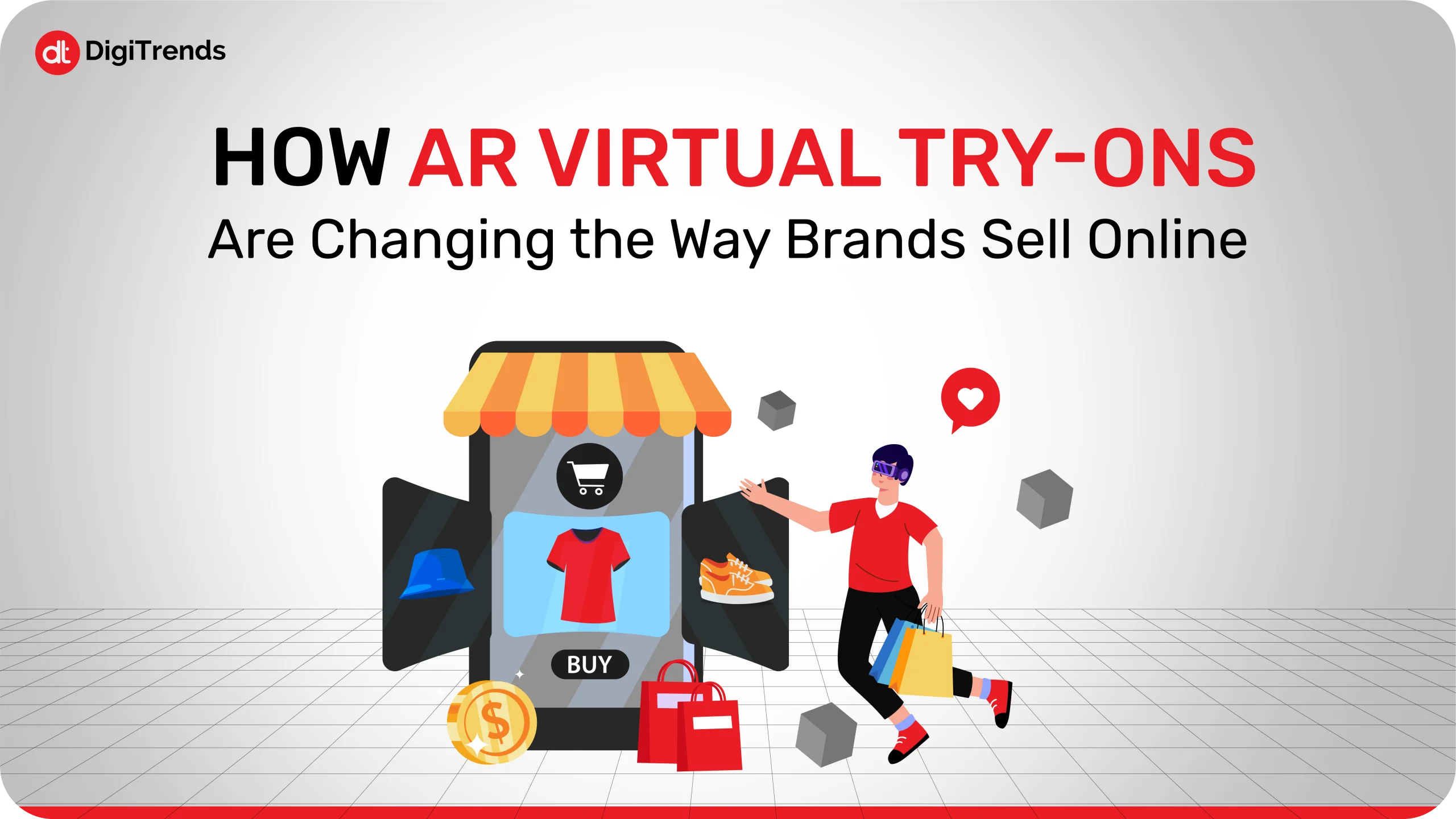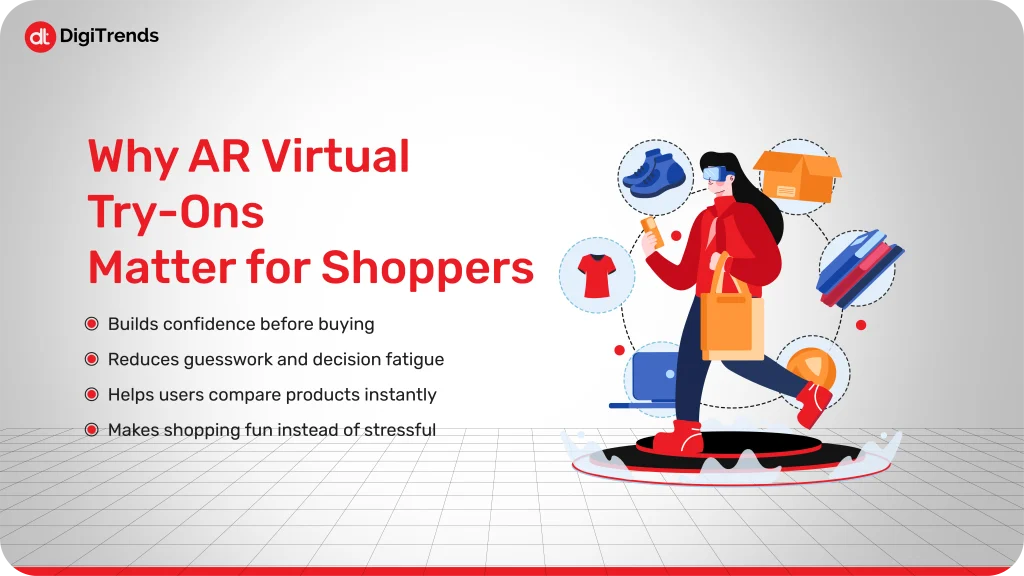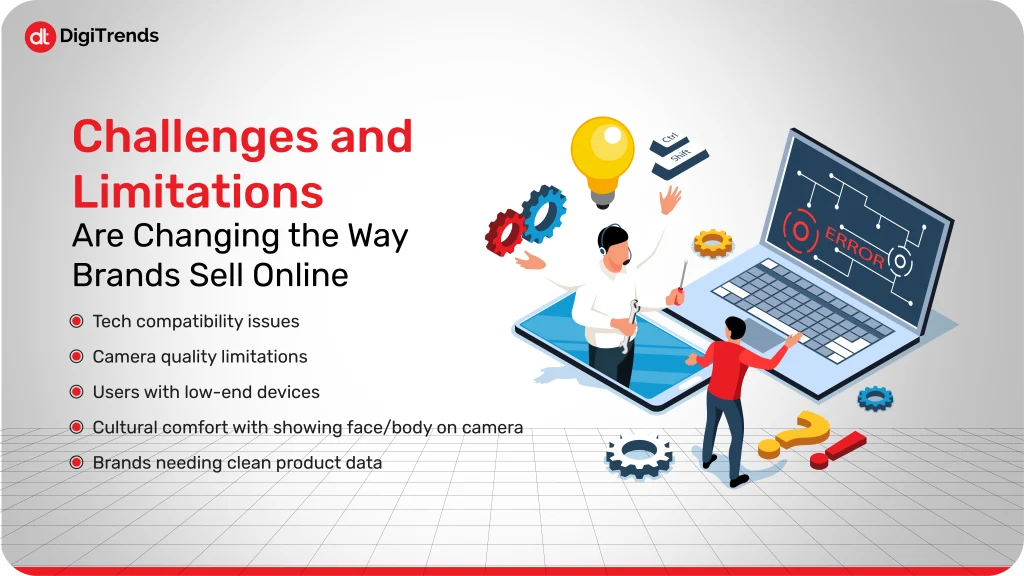
How AR Virtual Try-Ons Are Changing the Way Brands Sell Online
AR virtual try-ons can be the game changer for your e-commerce brand, explore how various industries are using it and its challenges.
Continue Reading
There is always a big blind spot in online shopping.
Being sure of how something will look when it arrives is not possible through zooming in on those pictures and reading a ton of mixed reviews. While shopping online, there’s always a mix of curiosity and confidence, and that’s exactly where shoppers hesitate to buy the product, so they either end up abandoning the cart or switching to another brand.
How can AR virtual try-ons help with online shopping?
Augmented reality virtual try-ons help online shoppers instantly see how a product would look on them, whether it is clothes, furniture, or anything else. You can easily point your phone at your face, feet, room, or body and have an idea of how the product will look. You can skip the guesswork of imagining colors and checking the size chart numerous times. You can get a clear and instant personal review.
What does it mean for a retail brand?
As a retail brand, it is time to understand that brands are no longer just looking to provide the best quality product, but they are also strategizing to provide their customers with the best experience before they even buy the product.
If you are a retail brand, AR virtual try-ons can be the factor that can help your customers make faster decisions, reduce returns, and also improve your customer loyalty.
Explore more about how AR virtual try-ons can be the game changer for your e-commerce brand, how various industries are using it for their advantage, its challenges and limitations, and more.

The reality of online shopping is that it can feel risky. Shoppers often don’t click on checkout when they are unsure how a product would look in their room, on their body, or on their feet.
That’s where AR virtual try-ons come in, giving customers a sense of confidence. It provides them with a glass of clear imagination and honesty, which is what all online shoppers need. Let’s have a look at why augmented reality shopping matters for shoppers:
As an online shopper, imagine if you could virtually try on glasses and see exactly how they would look on your face, or if you could try on hundreds of different lipstick shades to get that perfect match for your skin tone. You would instantly click checkout when satisfied, right? There will be no second thoughts about what if this product doesn’t suit me like I want it to. This is how AR virtual try-ons give customers the confidence to buy.
Let’s be honest, we’ve all abandoned carts because we weren’t sure about several things, like size, fit, or style. A virtual product experience removes that guesswork, and instead of relying on size charts, you can simply try on products virtually in just a few taps and reduce the decision fatigue when shopping online.
The try-before-you-buy AR technology also helps online shoppers in comparing multiple products side by side before making a decision. Oftentimes, we like two products but can only buy one, and then the most difficult decision comes: deciding between the two things you like. We desperately wish we could actually know which one would look perfect, right? Augmented reality shopping can actually help us compare the products and decide which one we should go with, which saves our time and mental energy.
Shopping online can often feel like a task that requires too much effort and attention. The AR e-commerce technology can add a fun part to online shopping by making it more engaging and entertaining, by providing a virtual product experience. This also gives customers a sense of a special bond with the brand.
Returns are one of the most annoying aspects of online shopping. Customers are less likely to be dissatisfied when a product is delivered, when they can virtually try it first. In addition to saving them trouble, this increases brand trust.
As much as AR virtual try-ons are a hit for customers, this technology also benefits brands. Let’s have a look at what advantages investing in AR e-commerce technology provides to the brands:
Online shoppers are most likely to buy the product when they can actually see how the product is going to look in their space or on them. AR virtual try-ons provide the customers with confidence to click on checkout without hesitating, which for brands means higher sales.
In online shopping, customers often misjudge the size, colors, or style, and when the product does not turn out to their liking, they instantly return it. According to research, the average online return rate has climbed to 16.9% in 2025. This implies how advantageous investing in augmented reality shopping can be for e-commerce brands. The customer will make decisive decisions when buying, leading to a reduction in post-purchase regrets and eventually helping brands lower return rates.
The experience that customers get on a specific website also plays a major role in deciding how long they stay. If your website or e-commerce store will offer augmented reality shopping, the customer will get engaged in trying on different colors, styles, and combinations. The longer they stay on the website, the more chances of them purchasing something, and the most important benefit is that they will remember the brand because of that one little fun experience.
Let’s be honest, trying on things virtually before buying is exactly what a customer wants. When brands keep in mind the needs and wants of their customers, the customers feel that the specific brand better understands them and works hard to provide innovative solutions. This enhances the level of customer loyalty, and satisfied customers might also recommend the brand to others, leading to more customers and website traffic.
AR virtual try-ons can do more for your brand than you think they can.
This AR e-commerce technology will help you generate data on how customers interact with your products. For example, you can get details on which colors, styles are tried the most, which products are abandoned. These are some valuable customer insights that you can use to better optimize your inventory, increase the most-liked product, and also strategize better marketing campaigns.
Wondering if the virtual product experience technology is limited only to one product?
Well, that’s not the case; this technology is transforming various industries by helping brands provide their customers with an online shopping experience that is interactive, confident, and enjoyable. Let’s have a look at which industries are benefitting from augmented reality shopping technology:
Makeup and skincare brands are among the first ones to adopt this technology. Online shoppers can easily try on different lipstick shades, foundation tones, and more virtually. It helps customers in buying new products without stepping out, going to the stores, and purchasing makeup after trying it on. They can simply try everything virtually and check how it would look on them while chilling at home.
Clothing and shoes are one of the things that people struggle with the most when shopping online because of size and style issues. AR lets customers know how a piece of cloth or shoes would fit them or look on them. This reduces any uncertainty, and for brands, it reduces the amount of returns.
AR virtual try-ons for glasses and sunglasses are the best. While in traditional shopping, customers struggle to find the perfect fit of glasses for their face shape, the best color that suits their skin tone, AR technology helps them virtually try on hundreds of frames until they can find their perfect match. The precise help in finding the best product according to the customer’s needs and taste makes a big difference in customer satisfaction.
Purchasing furniture online can be really tricky. You might think of questions like Will this sofa fit in my living room? Would the lamp match the aesthetic of my house? With AR technology, you can actually place the furniture and home decor products in your real environment virtually. You can check the size, color, and style instantly and check if the product is up to your aesthetic and needs.
Watches, bracelets, and rings are tiny objects that frequently need to be seen on the body in order to appreciate size and style. AR virtual try-ons make online jewelry shopping more convenient and pleasurable by allowing customers to rotate and view pieces on their hand, wrist, or neck.
Car accessories or even full vehicles can benefit from AR. Shoppers can see rims, decals, or even car interiors virtually before buying. This level of interaction enhances confidence in high-value purchases.
As the AR virtual try-ons technology can be beneficial for so many industries, it is expanding really fast. If you are an e-commerce business, this might be the right time to adopt this technology and provide a satisfying experience to your customers.
The idea of adopting an augmented reality shopping technology sounds cool, but what can make it strong? Let’s have a look at the factors that separate a good AR experience from a great one:
The foundation of a good AR virtual try-on is how realistic the product representation is. The colors, textures, and sizes must match the exact item. If the customers feel the virtual experience is off, they might lose trust and never come back.
Imagine if you are excited to virtually try on a t-shirt and see how it’s gonna look on you, but the system keeps lagging and you struggle with the speed of the try-on, you’ll be dissatisfied, right? This is why fast loading and smooth performance matter a lot in a virtual product experience.
For wearable products like glasses, makeup, clothing, or shoes, the AR system must track movement accurately. Misaligned or jittery overlays ruin the sense of realism and can make users abandon the experience.
Shoppers are subconsciously looking for realism. Proper lighting, shading, and shadows make the product feel “anchored” in real life. AR virtual try-ons that ignore these details feel flat and less trustworthy.
The best AR experiences are easy to use. Users should be able to rotate, zoom, or switch colors with minimal effort. Complicated controls frustrate shoppers and reduce engagement.
After trying a product, the next step should feel natural. Clear calls-to-action like “Add to Cart” or “Buy Now” integrated directly into the AR interface help convert curiosity into sales.
Most AR virtual try-ons happen on smartphones. Optimizing for mobile screen sizes, camera access, and processing power is crucial. A desktop-only experience misses the majority of online shoppers.
Some of the most engaging AR experiences let shoppers save favorite looks, share their try-ons on social media, or get recommendations based on previous interactions.
This creates a deeper connection with the brand.
By focusing on these factors, brands can make AR virtual try-ons feel effortless, fun, and realistic. The goal is to give shoppers confidence while keeping them engaged.

AR virtual try-ons sound perfect on paper, but there are a few real-world challenges brands need to understand before diving in. These don’t make AR any less valuable; they just help set realistic expectations.
Not every device handles AR the same way. High-end phones offer smooth tracking and fast rendering. Older or budget devices might struggle, which can lead to a choppy experience. Brands need to ensure their AR tools adapt across a wide range of devices.
AR relies heavily on the user’s camera. If the camera is low quality or the lighting is poor, the virtual product may not look as sharp or accurate as intended. This can affect how realistic the try-on feels.
Some users simply won’t have the processing power needed for advanced AR features. That means brands must consider lighter versions of the experience or a fallback option so no one feels left out.
Not everyone feels comfortable using their phone camera to try on products. In some regions, people may hesitate due to privacy concerns. Building trust through clear permissions and transparent communication is important.
AR systems depend on accurate dimensions, textures, and colors to build realistic 3D models. If a brand’s product data is messy or outdated, the AR model won’t match the real product. That mismatch can lead to disappointment and returns.
High-quality AR experiences require investment. Brands need 3D modeling, testing, integration, and ongoing optimization. While the ROI is strong, the initial setup shouldn’t be underestimated.
AR virtual try-ons have already changed how people shop, but this is only the beginning. As the technology evolves, the shopping experience will feel even more personal, accurate, and immersive.Here’s what’s coming next:
AR and AI are becoming a powerful duo. Soon, shoppers won’t just try on products; the system will recommend what suits them best. Think of it as a smart stylist suggesting shades, sizes, or styles based on your face shape, preferences, or past buys.
Imagine pointing your camera at your body and instantly getting the right size for a jacket or shoe. No more guessing, no more size charts. AR combined with body scanning is heading in that direction, making online shopping a lot more accurate.
Instead of browsing a flat website, shoppers will explore virtual stores. Walk through aisles, pick up items, mix and match outfits, and check how products look in different environments. It turns online shopping into an experience instead of a chore.
Product models will look even more lifelike. Fine details like fabric movement, skin reflection, or metal shine will appear exactly as they would in real life. This level of realism will make AR virtual try-ons feel almost indistinguishable from physically testing products.
AR won’t stay limited to apps or websites. You’ll see it across social platforms, messaging apps, video calls, and even smart glasses. Shopping experiences will follow customers wherever they spend their time.
As devices get better and AR tools get more optimized, the experience will feel smoother. No lag, no loading pauses, just instant, natural interactions that fit into daily life.
The future of AR in e-commerce is about making digital shopping feel more human. Less guessing, more confidence. Less scrolling, more experiencing. And for brands, it opens doors to stronger engagement, deeper loyalty, and smarter decision-making.
If you’re exploring AR virtual try-ons, you don’t have to figure it out alone. DigiTrends works closely with brands that want to elevate their digital presence and create experiences that feel modern, intuitive, and customer-focused. Whether you’re looking to understand what AR could look like for your products, map out a strategy, or build a prototype to test the idea, our team can guide you through each step.
We help you shape the concept, define the user journey, and design an experience that fits your brand. The goal is simple: give your customers a smarter, more confident way to shop while helping your business stay ahead of how people buy today.

AR virtual try-ons are reshaping the way people shop. They remove the uncertainty that comes with online buying and give customers a clearer sense of how products will fit into their lives. What this really means is that shoppers feel more confident, brands see stronger conversions, and the overall experience becomes more personal and interactive.
As the technology moves forward, AR will shift from a nice-to-have feature to something customers expect. Brands that start exploring it now will be better prepared for the future of e-commerce, where clarity and convenience matter more than ever.
If you’re curious about how AR could work for your products or want to explore what’s possible, this is the right time to start the conversation.